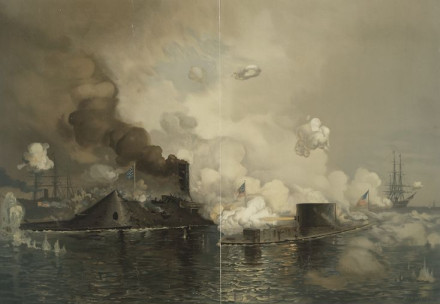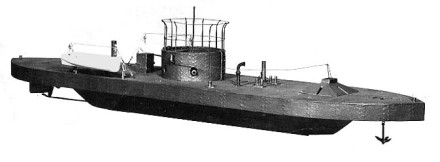History
A new era in naval warfare
The battle that is called the Battle of Hampton Roads (but is often referred to as the Battle of the Monitor and Merrimack) turned out to be a turning point in naval warfare. It was the most noted and arguably most important naval battle of the American Civil War from the viewpoint of the development of navies. It was fought over two days, on March 8 and 9, 1862, in Hampton Roads, a roadstead in Virginia where the Elizabeth and Nansemond Rivers meet the James River just before it enters Chesapeake Bay. The battle was a part of the effort of the Confederacy to break the Union blockade, which had cut off Virginia's largest cities, Norfolk and Richmond, from international trade.

USS Monitor versus Merimack.
The Merrimack was a Northern-built conventional steam frigate which had been taken from the Norfolk navy yard by the Confederates who renamed her Virginia. They cut away her upper hull and armoured her with iron. She was commanded by commodore Franklin Buchanan and together with several other Confederate vessels they decimated a Union fleet of wooden warships near Newport News in Virginia on March 8, 1862.
The Monitor, an ironclad ship of the Union commanded by Lieutenant John Worden, arrived the same night. This ship represented an entirely new concept in naval design and was completely reïnforced with iron and had an armoured revolving gun turret. On March 9, the battle between the two began. The crews lacked training so many fired shots missed. The Monitor could fire only once in seven or eight minutes but was faster and more maneuverable than her larger opponent. After a period of firing back and forth, the Monitor’s pilothouse was hit, driving iron splinters into Worden’s eyes. The ship sheered into shallow water, and the Virginia, concluding that the enemy was disabled, turned again to attack the Minnesota, another ship that was near. But due to low ammunition, a leak in the bow, and difficulty in keeping up steam, they decided to retreat to the navy yard.
The spectacular success of the Virginia on March 8 heralded a new era in naval warfare, the days of wooden navies were over. Later, on May 9, 1862, following the Confederate evacuation of Norfolk, the Virginia was destroyed by its crew. The Monitor was lost with 16 crewmen during a gale off Cape Hatteras, North Carolina, on December 31, 1862.
Description
The Monitor with its turret was the prototype for today's modern, all-metal warship, even though it was still an iron clad wooden ship.
Propulsion: a vibrating side-lever steam engine with 1 propeller.

| People on board | 16 |
|---|---|
| Power | 400 hp |
| Length | 172 feet (52.4 m) |
| Draft | 9 ¾ feet (3 m) |
| Beam | 41 ¾ feet (12.7 m) |
Status
The wreck of the Monitor was located in 1973 by scientists aboard the Duke University vessel Eastward. It was lying upside down on the seabed. In 2001 and 2002 marine salvagers raised the ship’s steam engine, gun turret and other artefacts from the wreckage.
References
- Encyclopaedia Brittanica.
Battle of the Monitor and Merrimack. - The steam engine of the USS Monitor.